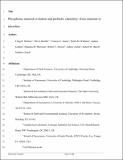Files in this item
Phosphorus mineral evolution and prebiotic chemistry : from minerals to microbes
Item metadata
| dc.contributor.author | Walton, Craig | |
| dc.contributor.author | Shorttle, Oliver | |
| dc.contributor.author | Jenner, Frances | |
| dc.contributor.author | Williams, Helen | |
| dc.contributor.author | Golden, Joshua | |
| dc.contributor.author | Morrison, Shaunna | |
| dc.contributor.author | Downs, Robert | |
| dc.contributor.author | Zerkle, Aubrey | |
| dc.contributor.author | Hazen, Robert | |
| dc.contributor.author | Pasek, Matthew | |
| dc.date.accessioned | 2022-09-07T23:45:45Z | |
| dc.date.available | 2022-09-07T23:45:45Z | |
| dc.date.issued | 2021-09-08 | |
| dc.identifier | 275802031 | |
| dc.identifier | d0dafc37-2334-48b7-8cc7-0ecddc9f46ba | |
| dc.identifier | 85115209539 | |
| dc.identifier | 000703300600002 | |
| dc.identifier.citation | Walton , C , Shorttle , O , Jenner , F , Williams , H , Golden , J , Morrison , S , Downs , R , Zerkle , A , Hazen , R & Pasek , M 2021 , ' Phosphorus mineral evolution and prebiotic chemistry : from minerals to microbes ' , Earth-Science Reviews , vol. In press , 103806 . https://doi.org/10.1016/j.earscirev.2021.103806 | en |
| dc.identifier.issn | 0012-8252 | |
| dc.identifier.uri | https://hdl.handle.net/10023/25970 | |
| dc.description | This research was funded by NERC, grant number NE/L002507/1, UKRI. Sloan, Deep Carbon Observatory, Keck, Templeton, NASA Astrobiology Institute, and a private foundation are all acknowledged for their support. F.J acknowledges funding from the NERC ‘Deep Volatiles’ consortium grant (NE/M000427/1). H.W. acknowledges funding from the NERC ‘Mantle Volatiles’ consortium grant (NE/M000303/1) and from the ERC Consolidator Grant 306655 (‘Habitable Planet’). M.P. acknowledges funding from NASA Exobiology grant 80NSSCC18K1288. | en |
| dc.description.abstract | Phosphorus availability is considered a limiting factor in many scenarios for the origin of life. The concentration of P in environments of prebiotic interest will have been governed by the available mineral sources of P on the early Earth. A knowledge of early Earth P mineralogy and prevailing global and local environmental conditions is therefore needed to understand which scenarios for prebiotic chemistry are most plausible. Here, we review the plausible diversity of P-bearing phases at Earth's surface during the emergence of life. We consider phases that were delivered by meteorites (exogenous phases), as well as those that developed solely as a result of Earth system processes (endogenous phases). We take into account the known formation conditions of individual phases, as well as the observed temporal distributions of P-bearing minerals found at Earth's surface today. Our approach allows us to leverage what is known about changes in the Earth system in order to rule out the prebiotic relevance of many P-bearing phases. Meanwhile, we highlight a small number of phases that are of possible prebiotic relevance; specifically, exogenous schreibersite, merrillite, and apatite, and endogenous apatite, olivine, and glass. Prebiotic mineral-chemical scenarios can be formulated for each phase, with distinct requirements for the environmental and tectonic state of early Earth. We can therefore relate the plausibility of mineral-chemical scenarios to the nature of early Earth, bridging the fields of geoscience and prebiotic chemistry. | |
| dc.format.extent | 4369052 | |
| dc.language.iso | eng | |
| dc.relation.ispartof | Earth-Science Reviews | en |
| dc.subject | Prebiotic | en |
| dc.subject | Chemistry | en |
| dc.subject | Origin | en |
| dc.subject | Life | en |
| dc.subject | Early Earth | en |
| dc.subject | Geology | en |
| dc.subject | Minerals | en |
| dc.subject | Phosphorus | en |
| dc.subject | Phosphate | en |
| dc.subject | Meteorite | en |
| dc.subject | QE Geology | en |
| dc.subject.lcc | QE | en |
| dc.title | Phosphorus mineral evolution and prebiotic chemistry : from minerals to microbes | en |
| dc.type | Journal item | en |
| dc.contributor.institution | University of St Andrews. St Andrews Centre for Exoplanet Science | en |
| dc.contributor.institution | University of St Andrews. School of Earth & Environmental Sciences | en |
| dc.contributor.institution | University of St Andrews. St Andrews Isotope Geochemistry | en |
| dc.identifier.doi | https://doi.org/10.1016/j.earscirev.2021.103806 | |
| dc.description.status | Peer reviewed | en |
| dc.date.embargoedUntil | 2022-09-08 | |
| dc.identifier.url | https://www.sciencedirect.com/science/article/pii/S001282522100307X#s0110 | en |
This item appears in the following Collection(s)
Items in the St Andrews Research Repository are protected by copyright, with all rights reserved, unless otherwise indicated.

